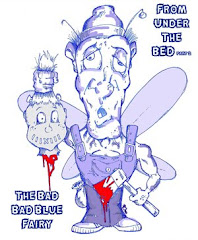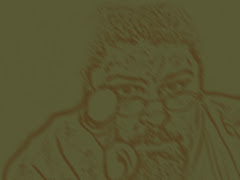Last year I became something of a sizable Dr. Who fan. It didn't take much really, since it's such a well written, superbly directed, and fantastically acted Sci-Fi show that just so happens to have been around since the 60's. The current Doctor, David Tennant, is so likable and so much fun to watch that it makes the show as a whole infinitely more enjoyable. Here is a bit of history about Dr. Who:
'Doctor Who is a British science fiction television programme produced by the BBC. The programme depicts the adventures of a mysterious alien time-traveller known as "the Doctor" who travels in his space and time-ship, the TARDIS, which appears from the exterior to be a blue 1950s police box. With his companions, he explores time and space, solving problems, facing monsters and righting wrongs. The programme is listed in Guinness World Records as the longest-running science fiction television show in the world and is also a significant part of British popular culture. It has been recognised for its imaginative stories, creative low-budget special effects during its original run, and pioneering use of electronic music (originally produced by the BBC Radiophonic Workshop). In Britain and elsewhere, the show has become a cult television favourite and has influenced generations of British television professionals, many of whom grew up watching the series. It has received recognition from critics and the public as one of the finest British television programmes, including the BAFTA Award for Best Drama Series in 2006.
The programme originally ran from 1963 to 1989. After an unsuccessful attempt to revive regular production with a backdoor pilot in the form of a 1996 television film, the programme was successfully relaunched in 2005, produced in-house by BBC Wales in Cardiff. Some development money for the new series is contributed by the Canadian Broadcasting Corporation (CBC), which is credited as a co-producer. Doctor Who has also spawned spin-offs in multiple media, including the current television programmes Torchwood and The Sarah Jane Adventures, and the 1981 pilot episode K-9 and Company. The show's lead character is currently portrayed by David Tennant. In the programme's most recent series, which ran from 5 April to 5 July 2008, Catherine Tate played the Doctor's companion, reprising her role of Donna Noble from the 2006 Christmas special.[6] Another Christmas special will air in 2008, followed by four more specials in 2009; the next full series has been confirmed for airing in 2010.'
So, as those of you in the know are aware, the Doctor takes on nearly a different enemy each episode, though often ones he's tangled with in the past. In fact, it's those very adversaries that make for the best shows. Here are the top 10 in that particular category.
10) THE ZYGONS

The Zygons first appeared in the Fourth Doctor serial Terror of the Zygons, where it was revealed that centuries ago, the Zygon homeworld was destroyed in a stellar explosion. A craft escaped and somehow made it to Earth, where it then crashed into Loch Ness. When the Doctor encountered the Zygons, they were led by a warlord named Broton. Broton wished to conquer the world to allow a refugee fleet of Zygons to colonize Earth.
The Zygons have shape-shifting abilities, allowing them to replicate the appearance of another being, but they must keep the subject alive in order to use its body print. This skill was vital in their concealment and in their scheme to seize power despite their small numbers. The Zygons were also accompanied by an armored cyborg creature called the Skarasen, the lactic fluid of which was necessary for them to feed.
9) THE AXONS

The Axons land on Earth, desperately in need of fuel. They propose to exchange the miracle substance they call Axonite for some much needed energy. Axonite is a "thinking" molecule that can replicate any substance... or so they claim. As it turns out, the ship is a single organism called Axos whose purpose is to feed itself by draining all energy through the Axonite (which is just a part of itself), including the energy of every life form on Earth. The deception about the Axonite's beneficial properties was to facilitate the distribution of Axonite across the globe.
8) THE REAPER

Reapers appeared in the Ninth Doctor episode "Father's Day", written by Paul Cornell. Although not named on screen, they were referred to as "Reapers" in the publicity material for the episode. The production team based their design on the Grim Reaper, with their tails shaped like scythes.
Reapers are multi-limbed, flying reptiles similar to pterosaurs, with a large wingspan, sharp teeth both in the form of a beak and a secondary mouth in their torsos, coupled with a rapacious attitude. The Reapers are apparently extradimensional, materializing and dematerializing out of the space/time vortex. They are attracted to temporal paradoxes that damage time, like bacteria swarming around a wound. They then proceed to "sterilize" the wound by consuming everyone in sight.
7) THE KRYNOID

The Krynoids appeared in the 1976 Fourth Doctor story The Seeds of Doom by Robert Banks Stewart. They are a highly dangerous, sentient form of plant life which are renowned amongst galactic botanists. They spread via seed pods which travel in pairs and are violently hurled through space by frequent volcanic eruptions on their unnamed home planet. The pods when opened are attracted to flesh and are able to infect and mingle their DNA with that of the host, taking over their body and slowly transforming them into a Krynoid. The species can also exert a form of telepathic control over other plant life in the surrounding area, making it suddenly dangerous and deadly to animal-kind. In the later stages of development the Krynoid can also control the vocal cords of its victims and can make itself telepathically sympathetic to humans. Fully grown Krynoids are many meters high and can then release hordes of seed pairs for further colonisation.
6) THE CYBERMEN

Cybermen were originally a wholly organic species of humanoids originating on Earth's twin planet Mondas that began to implant more and more artificial parts into their bodies as a means of self-preservation. This led to the race becoming coldly logical and calculating, with emotions usually only shown when naked aggression was called for.
They were created by Dr. Kit Pedler (the unofficial scientific advisor to the programme) and Gerry Davis in 1966, first appearing in the serial, The Tenth Planet, the last to feature William Hartnell as the First Doctor. They have since been featured numerous times in their extreme attempts to survive through conquest.
A parallel universe version of the Cybermen appeared in the 2006 series' two-part story, "Rise of the Cybermen" and "The Age of Steel".
5) THE SLITHEEN

The Slitheen first appeared in the 2005 series episodes "Aliens of London" and "World War Three", and subsequently recur in later episodes of both Doctor Who and spin-off series The Sarah Jane Adventures. They are creatures of living calcium, hatched from eggs and native to the planet Raxacoricofallapatorius. While, strictly speaking, the name "Slitheen" refers to a specific family, the term has been used by the Doctor and Rose to refer to the Raxacoricofallapatorian race in general.
The Slitheen are a ruthless criminal sect whose main motivation is profit, but they have an almost ritualised love of hunting, being trained to hunt and kill from a young age. The members of the family are convicted criminals on their planet, being subject to the death penalty.
4) THE SONTARANS

In the episode The Poison Sky, it is revealed that the Sontaran society revolves around the Sontaran Empire, and that they have been at war with the Rutan Host for more than 50,000 years,[2] and which, at a time around 2008, they are losing. However, the war is still raging at least 20,000 years later, in the serial The Sontaran Experiment.
The Sontarans have a highly militaristic culture; every aspect of their society is geared toward warfare, and every experience is viewed in terms of its martial relevance. In The Sontaran Experiment, the Fourth Doctor comments that "Sontarans never do anything without a military reason." Aside from a ritualistic chant (shouting the phrase "SONTAR-HA!" repeatedly while slapping their right fist into their left palm) in "The Sontaran Strategem"/"The Poison Sky", they are never seen to engage in any activity that would be considered recreation, though a few offhand comments by Commander Skorr in "The Poison Sky" suggest they do consider hunting a sport.
3) VASHTA NERADA

Vashta Nerada (literally: the shadows that melt the flesh) are microscopic swarm creatures which, when present in a high enough concentration, are totally indistinguishable from shadows, and use this to their advantage in approaching and attacking prey. They are described as the "piranhas of the air", able to strip their victims to the bone in an instant in high enough densities. The Doctor says that almost every planet in the universe has some, including Earth, and claims that they can be seen as the specks of dust visible in unusually bright light. On most planets, however, Vashta Nerada exist in relatively low concentrations, and are carrion eaters (on Earth, Vashta Nerada are said to subsist largely on roadkill), with attacks on people being comparatively rare (although the Doctor does attribute the seemingly irrational fear of darkness common to many species as a perfectly rational fear of the Vashta Nerada). In the episode "Silence in the Library", an unusually high concentration of Vashta Nerada had completely overrun the 51st century "Library" (an installation covering the surface of an entire planet and apparently containing every book ever written), resulting in the apparent death of everyone inside at the time. Vashta Nerada normally live in forested areas, and reproduce by means of microscopic spores (from which they hatch) which can lay dormant in wood pulp. In the episode "Forest of the Dead", this is revealed to be the reason for their unusual prevalence in The Library, as it is made known that the books and The Library itself were constructed of wood from the Vashta Nerada's native forest feeding grounds.
2) THE MASTER

A would-be universal conqueror, the Master's stated goal is to control the universe (in The Deadly Assassin his ambitions were described as becoming "the master of all matter", and in "The Sound of Drums" he acknowledges that he chose the name "the Master"), with a secondary objective of eliminating and/or hurting the Doctor. His most distinctive ability is that of hypnotising people by fixing them with an intense stare, often accompanied by the phrase, "I am the Master, and you will obey me." The original (and most common before 1996) look of the character was similar to that of the classic Svengali character; a black Nehru outfit with a beard (which the Fifth Doctor called "rubbish" in "Time Crash") and moustache. A favoured weapon of the Master is his Tissue Compression Eliminator, which reduces its targets to doll-size, usually killing them in the process -- although when the Master was brought back in the 2007 series, he was equipped with a laser screwdriver.
In his three seasons beginning with Terror of the Autons, the Master (as played by Delgado) appeared in eight out of the fifteen serials. Indeed, in his first season the Master is involved in every adventure of the Doctor's, always getting away at the last minute before he is captured in The Dæmons (1971), only to escape imprisonment in The Sea Devils (1972). He would often use disguises and brainwashing to operate in normal society, while setting up his plans; he also tried to use other alien races and powers as his means to conquest, such as the Autons and the Daemons. Delgado's portrayal of the Master was as a suave, charming and somewhat sociopathic individual, able to be polite and murderous at almost the same time.
Delgado's last on-screen appearance as the Master was in Frontier in Space, where he is working alongside the Daleks and the Ogrons to provoke a war between the Human and Draconian Empires.
1) THE DALEKS

Externally, Daleks resemble human-sized salt and pepper shakers around five to six feet (152 to 183 cm) tall, with a single mechanical eyestalk mounted on a rotating dome, a exterminator arm containing an energy weapon (or "death ray"), which in some episodes fired a gas and can also be fitted with a projectile weapon, and a telescoping robot manipulator arm (plunger).
The death ray possesses incredible firepower for its size. It can kill almost any mortal lifeform, level houses, and destroy entire spacecraft. Under certain circumstances, Daleks are shown equipped with additional weaponry. Daleks protecting the Emperor in "The Parting of the Ways" have an additional energy cannon in place of their manipulator arm. During the Dalek civil war, Davros created the Special Weapons Dalek, a heavily armored Dalek sporting a massive cannon capable of destroying two Daleks and vaporising a human completely. The Special Weapons Dalek is only deployed in rare situations, as (according to the novelization of Remembrance of the Daleks) it is a one-off mutation resulting from the radiation backfired by its weapon, which other Daleks regard as 'the Abomination'.
In most cases, the manipulator resembles a sink plunger, but Daleks have been shown with arms that end in a tray, a mechanical claw, or other specialised equipment like flamethrowers and cutting torches. The arms have a strong magnetic field, a powerful suction vacuum and Daleks have used their plunger-like manipulator arms (the plunger was used because of cost issues for the first series) to interface with technology, crush a man's skull, measure the intelligence of a subject, and extract the brainwaves from a man's head (fatal, although it is implied that it doesn't need to be). Dalek casings are made of a bonded polycarbide material dubbed "dalekanium" by a human in The Dalek Invasion of Earth. The Daleks also use this term for the material.
The lower half of a Dalek's shell is covered with protrusions — "Dalek bumps" — which are spheres embedded in the casing. These are described as "sense globes" or sensors in The Doctor Who Technical Manual by Mark Harris (which is of uncertain canonicity). However, in the 2005 series episode "Dalek", they are also part of a self-destruct system. The casings are vulnerable to "bastic"-headed bullets, and when breached tend to explode. Normal 21st century bullets have no effect, however, and even a rocket does only minor damage. However, during the Dalek civil war, the Special Weapons Dalek is shown to carry extremely tough armour. Whilst scarred and battle damaged, the casing can deflect incoming shots from enemy Daleks with ease. Coupled with amazing firepower, the Special Weapons Dalek can wipe out a squad of Daleks.
This is not to say that Daleks wear explosive armour, but it implies that a lot of destructive power is needed to destroy Daleks. The armour has a forcefield that evaporates most bullets and absorbs most types of energy weapons, though normally ineffective firepower can be concentrated on the eyestalk to blind the Daleks. The shields however can be penetrated by their own weaponry: notably the miniature Dalek guns wielded by human/Dalek hybrids in Evolution of the Daleks. The hybrids outnumbered the Daleks Thay and Jast, and their firepower overwhelmed the shields. In "The Stolen Earth", Daleks created from the cells of Davros appear not to have this forcefield. Bullets, stones and human hands can physically touch the armour casings but with no effect.
The Dalek's eyepiece is its most vulnerable spot, and impairing its vision often leads to a blind, panicked firing of its weapon while shouting 'My vision is impaired - I cannot see!' The later Daleks developed systems to protect their vision. Wilfred Mott attempted to disable a Dalek with a paintball gun by blinding it with paint. The Dalek simply melted the paint off, announcing "My vision is not impaired", ruining the classic parody.










 Stumble It!
Stumble It!















No comments:
Post a Comment
Say it loud, say it proud!